You might be wondering: What are vision boards? A vision board is a visual representation of what we want to achieve. We can use it to show our end goal and where we see ourselves being in the future. Not only this, but a vision board will also help you show the process of how you envisage getting to these end goals. However, while there is a lot of support for vision boards, there’s also a lot against organizing ideas in this way. Because of the varying opinions on the topic, we can uncover how to make a vision board properly. We can explore why many often fail and the various drawbacks, and how you can make a vision board properly to achieve your goals and visions.
Why Do Vision Boards Fail?
Before you learn how to make a vision board, it’s important to cover why many fail in this area. After all, this method is talked about a lot, and there are lessons to be learned from both success and failure. Overall, the reason vision boards fail often comes down to your mindset. For example, say you’re checking Facebook and see some of your friends taking vacations, and you feel that urge to add that to your vision board. While that’s great, that may not be the best desire for you to have. Even though a vacation is nice, it doesn’t always mean this is what you want out of life. In other cases, it might be you’re not putting in enough effort to achieve your goals. Or perhaps deep down, you don’t think you can achieve what you’re putting on your board in the first place. These are all similar aspects to setting goals and writing them down. However, that similarity is where you’ll be able to thrive when making a vision board now and in the future.
When Do Vision Boards Work?
With a vision board, you will be able to see what it is that you want in the future and identify how you can get there. When you can see it, there, in front of you, then you are going to want to get there, and you are going to feel much more motivated to work towards these goals. Not only this, but the process of making a vision board is more fun than you may realize. This means that you can look forward to doing it rather than ignoring those goals and stopping yourself from achieving what you want in the future. Using a vision board means following some key steps that’ll allow you to manifest from it. Here are the simple ways how it’ll help you
Understand how manifestation works: These steps are asking, believing, and finally, receiving. Visualize your ask: Getting back to asking, you’ll have an easier time asking by visualizing. Your vision board should clarify that you’ll be able to ask for exactly what you’d like. Instill belief through goals: The third step is to instill belief in yourself. Merely thinking about it won’t help you to achieve your vision. You’ll need to set goals and use the vision board to reinforce that belief. Be present in your life: Many people fail at this step because they’re worried about the past or the future. This step is to remind yourself to keep working at it so that one day you’ll be ready to receive it. Furthermore, this step will help you to realize what you’ve received already and what you can use as you grow. Appreciate the now: The last thing is to show appreciation for things right now. Working towards goals is tough, but there is satisfaction at the end when completing it.
Making Vision Boards Work for You
While making a vision board is simple, what matters is ensuring that it works. If you’re sinking an hour or two into this, you want to make sure that it was worth your time and effort. With this in mind, I would encourage you to consider these pieces of advice before and after you make a vision board.
1. Think About What You’ve Achieved Recently
The first piece of advice is to consider everything that you have achieved over the past few years. Even though days and years are going by quickly, you’d be surprised what you have achieved over the course of a year. Make sure you pause and consider what you have accomplished thus far in your life. Remember the things that made you proud. Going in with this sort of mindset allows you to focus on what you can improve in your life moving forward. That way, you won’t focus on adding desires you’ve seen from other people but rather focus on your own. The next piece of advice will add another layer to this.
2. Look at the Direction of Your Life
It’s the dreaded question, “Where do you see yourself in five years?” However, outside of an interview, this is a good question to be asking yourself. Look at the direction that you’re facing in your life and ask yourself if you are happy with it. This is important because we all can change our lives. So often, we forget that we can gain control of our lives at any time. Keep in mind that you do not want to constantly change goals with a vision board. However, asking this question can influence how you build your vision board. Again, you’re putting your desires and goals on the board rather than letting other actions or opinions seep into your goal setting.
3. Consider What You Want To Change
Goals should be a stage that fulfills something that we lack in life. Maybe you struggle with moving around much. Or maybe you’ve got a business idea you’ve been sitting on for a long time. From desires to improve your marriage to having more vacations, you want to look at what you lack and how to make that abundant in your life. The previous pieces of advice allow you to narrow down precisely what your vision is and what sort of change you want to see in your life. When paired with this, you can focus on what you want to change right now in your life.
4. Don’t Overstuff Your Vision Board With Goals
Now that you have an idea of what goals you have, the next thing is turning them into visions. While you may be excited to place all of these goals on your board, it might not be the best idea. Unless you are someone who can focus on one goal at a time, most people will find the influx of goals to be overwhelming. While we all feel excited about it, much of that stems from our dopamine high. It’s a feel-good drug, and it’s an addictive one. It also clouds our judgment so much that we tend to feel stressed or overwhelmed once reality sinks back in. So while you are making your vision board, try to consider alternatives. Here are some ideas:
Introduce quotes or phrases that excite you and energize you. Consider post-it notes and writing down the steps to take to achieve a particular vision. Consider having a smaller board or increasing the size of the pictures you’re posting on the board. This forces you to put fewer things and focus on the visions that matter more to you.
5. Make Your Visions Emotional
There has been an emphasis on caring about these goals and working on your overall mindset, and it’s there for a reason. When working on goals in any way, there is always a mental component to it. To place more emphasis on it, you want to ensure that every action you do has emotion attached to it. After you’ve set up your vision board and are looking for it over, it pays to ask some questions to draw those emotions out.[1]. There are many great questions to consider, but one to ask yourself is: Why do I want to achieve this goal? The idea of this question is to look for a deeply personal reason. Some examples could include:
You want to spend time with your partner because you love them, and recently you’ve been drifting apart. You want to lose weight and improve your posture because of back pain. You want to build a business because you lacked the ambition to start it when you were younger.
You must find a reason why you are working towards this goal. Not only that, but you want to use it as a reminder for your work. This is so important because it gives us an overall purpose. When you have a purpose, you will begin to care more about the process and hone your skills.
Vision Board Ideas and Examples
Let’s look at some great examples of vision boards that can help us capture our dreams.
1. Words
Words are a great place to start when thinking up vision board ideas. Words have a mysterious way of impacting us and helping us feel good when used correctly. Whether the words describe feelings or echo states of being, they all evoke experiences we have had or wish to have [2]. Look at magazines to cut out words that describe how you want to be or what you want to feel. You can even write them in big, bold, colorful letters.
2. Quotes
Quotes are great sources of mindset formation and effectively express an idea or experience in its entirety, making them one of the great examples of vision boards. No matter what the context in which the words were originally said, the impact of a good quote is timeless.[3] Choose quotes that give rise to intense and accurate thoughts that match the state or experience you wish to arrive at. These can be from your role models, favorite authors, teachers, or even something out of a song. You can even add poems if they speak to you and your future goals.
3. Self-Affirmations
Self-affirmations are different from quotes since you write these on your own, for yourself. They are aimed at changing one’s worldview and undoing limiting beliefs. Research suggests that they can minimize anxiety, stress, and defensiveness associated with threats to our sense of self while having positive neuro-psychological effects and keeping us open to improvement.[4] Create affirmations that start with “I am” and challenge beliefs about money, success, ability, and skill[5]. Write affirmations that go beyond what you think is possible and change the “cannot” to “can.” Here are some affirmations you might find useful: 10 Positive Affirmations for Success that will Change your Life
4. Going Digital with Vision Boards
Making vision boards for different areas of your life might require space and time that you might not have. However, with digital vision boards, you can create as many as you like and access them on the go on your computer and mobile devices. To create a digital vision board, you can use online tools like Pinterest, Canva, or the tools available on your computer such as Paint to make a collage. To cut and save pictures online, use the Snipping Tool. Once you have made your vision board, you can then set it as your home screen, or screen saver, or put it on a slideshow to display when your computer is idle.
5. Pictures
Pictures are a wonderful alternative to doodles since they can snap you out of any hesitancy you might feel towards drawing. You can pin them to a corkboard, glue them to a poster board, or simply tuck them into a bulletin board. Depending on the vision you are working at fulfilling through your vision board ideas, you can put up images of associated people who are successful, and images that evoke feelings you wish to experience (gratitude, joy, love, success, etc.). If you’re inspired to use pictures, you may try creating a digital vision board.[6]. You can also find pictures that are similar to those you see in your imagination. If you wish to increase the challenge, you can have pictures representing different actions you will take.
6. Souvenirs
Souvenirs, as sources of inspiration, are highly potent. They can serve as reminders of your strengths, uniqueness, achievements, successful relationships, and positive associations.[7]. If there are souvenirs you associate with the birth of a specific vision, those are the ones that must go on the board. You can have anything from name tags, appreciation notes, trinkets, key chains, dry leaves, buttons, magnets, string lights, etc. The possibilities are endless.
7. Art or Doodles
When you’re coming up with vision board ideas, art or doodles are great ways to strengthen your desired states. Since you are representing your vision through imagery, there is no better way of owning it. You don’t have to be skilled in the art to create doodles. You just have to be willing to play! You can doodle your life map, or just use colors to intuitively express your feelings without form.[8] Draw your future successful self in your dream job or take your dream vacation. You can also doodle your favorite quote or your affirmation.
5 Steps to Creating a Vision Board
To create a vision board that will resonate with your dreams and vision and drives you toward their accomplishment, you can take the following steps:
1. Reflect and Write Out Your Dreams and Goals
What are the things that are most important to you? What are the big goals of your life? What would you like to accomplish in the next year, three years, or five years? What are those things you wish to accomplish in your lifetime? Think about these things and write them down.
2. Collect Relevant Images to Your Goals
After writing down your goals, it’s time to visualize them. Begin to collect relevant images of people, places, objects, texts, quotes, and even your pictures representing your mind’s images. You can cut out some magazine sections or find images on the internet. Type a search query on platforms like Pinterest, it will return loads of images that are relevant to your search.
3. Make a Collage from Your Collections
Assemble what you’ve got and then make a collage from them. Arrange them in a way that each of the items can be seen easily. You can place them on plane papers, cardboard, poster boards, etc.
4. Personalize Your Vision Board
Add your own words to your vision board, you can use markers, paints, stickers, quote cards, your computer, etc., to add words to those images in a way that will inspire you.
5. Display Your Vision Board
Display your vision board where you can get to see it every day. Place it in your bedroom, office space, or any other conspicuous place.
Final Thoughts
As you develop your vision board ideas, don’t forget to let your creativity rule. This isn’t something you’ll be publishing for everyone to see; it’s something that is meant to inspire you every day. Use some of the suggestions to help inspire you to create your goal board and then make it your own. Featured photo credit: Estée Janssens via unsplash.com
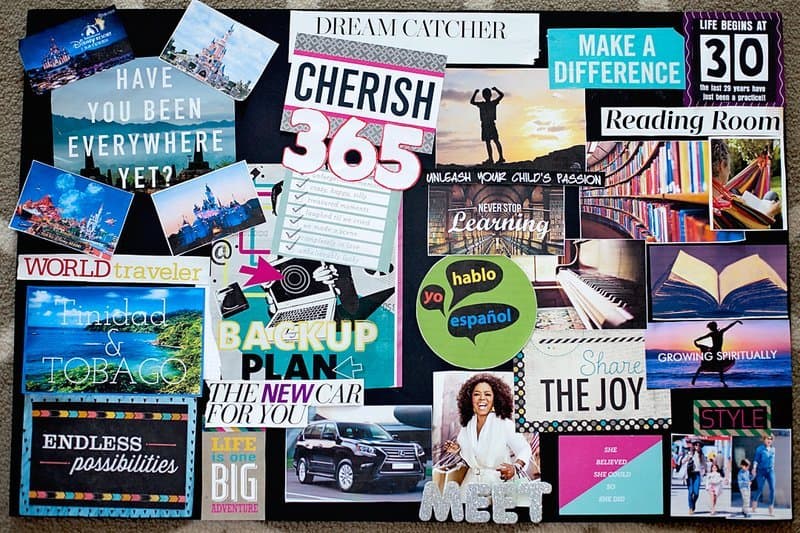
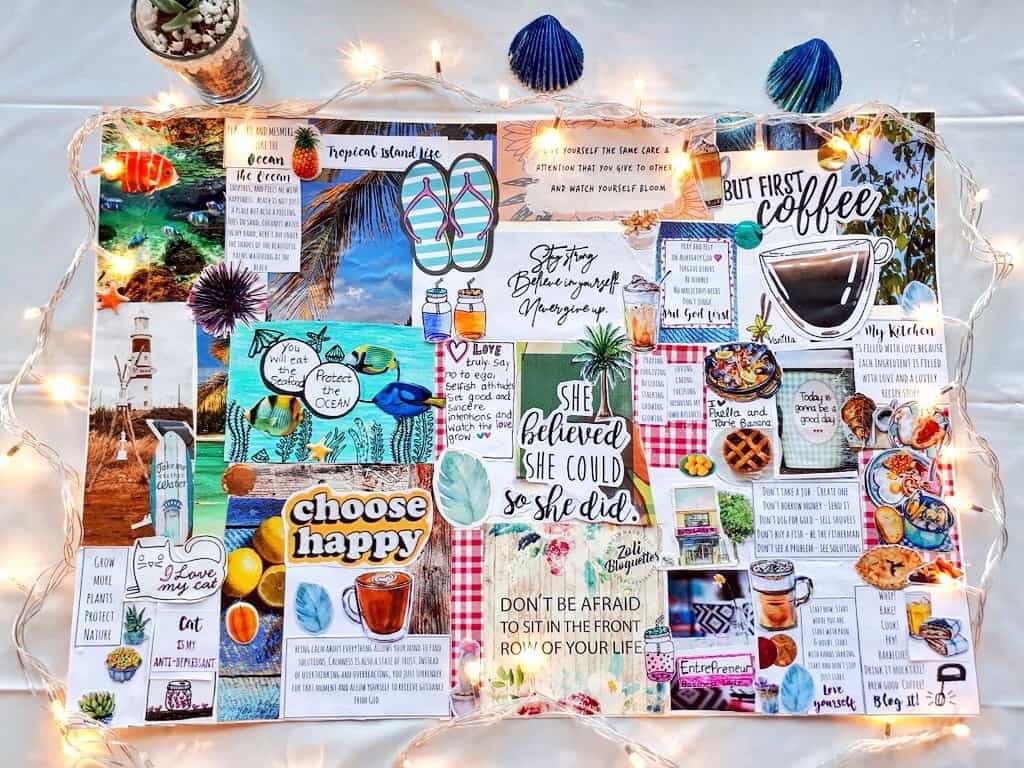
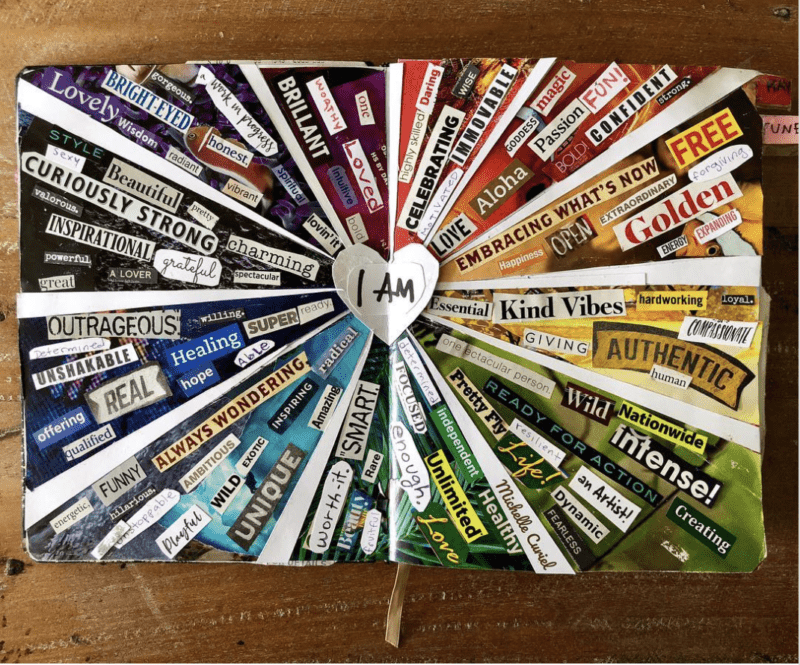
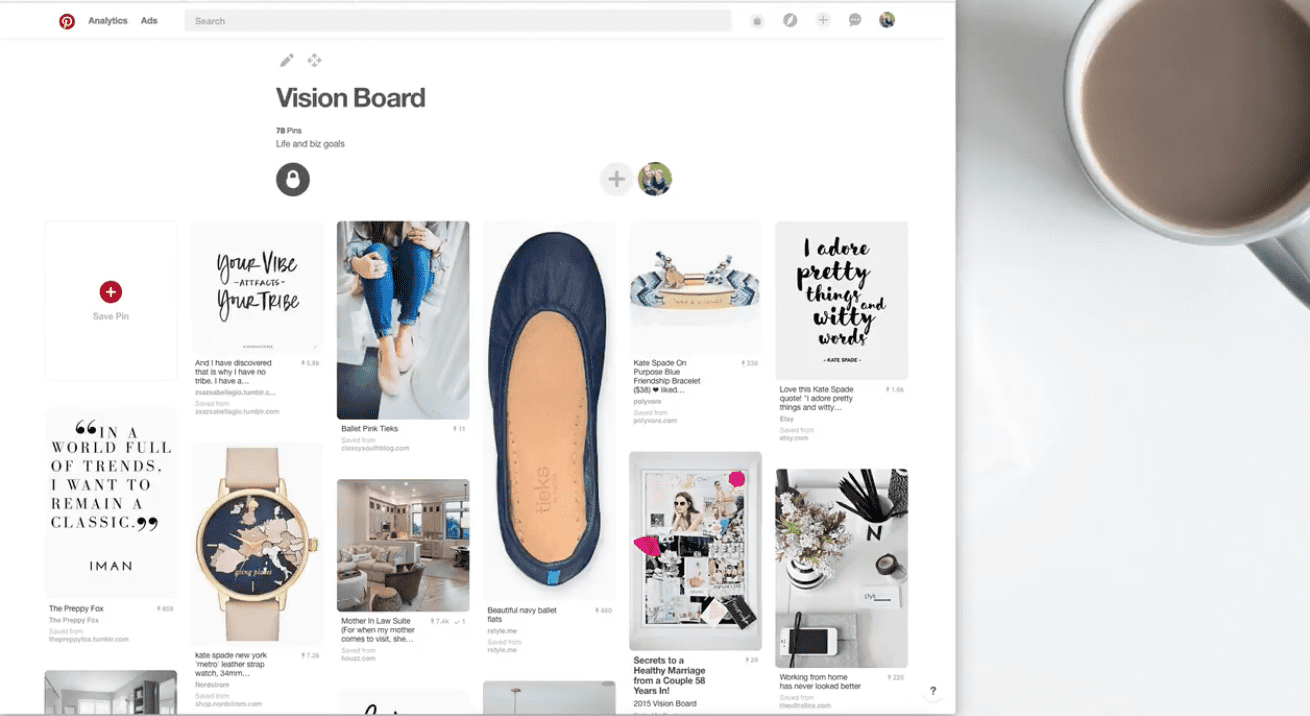

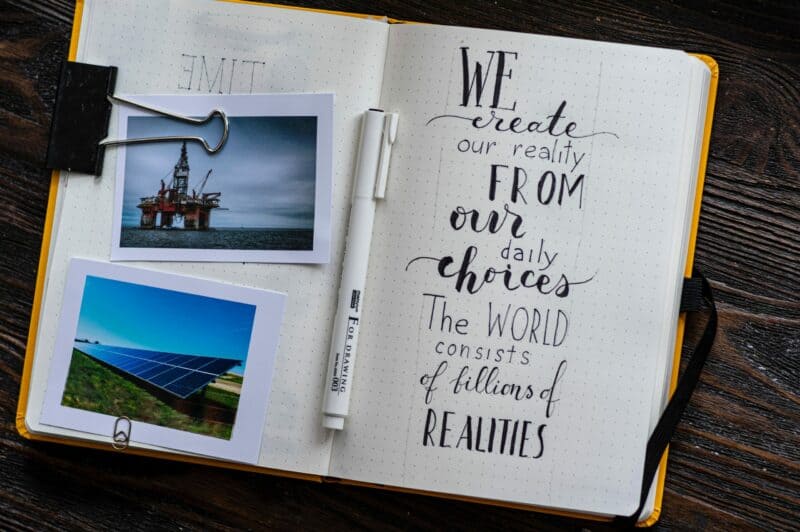
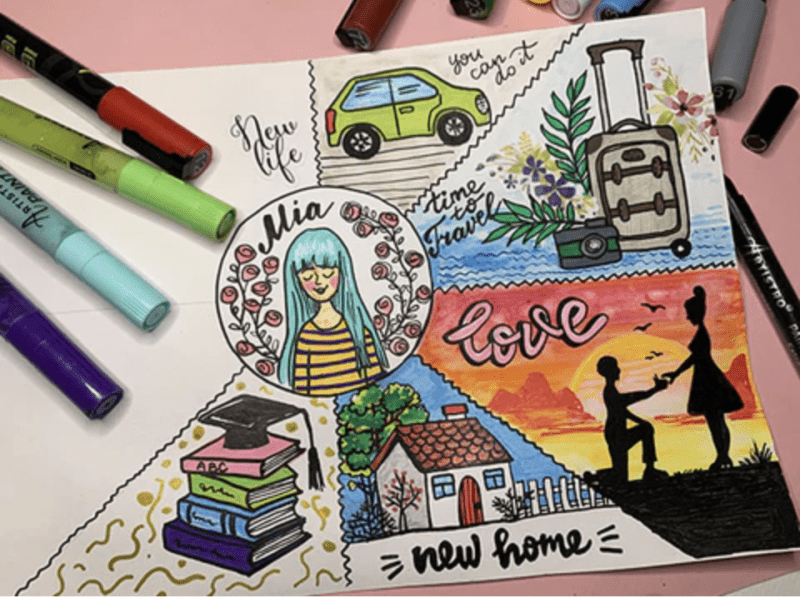
title: “Vision Board Ideas That Work And How To Make A Vision Board " ShowToc: true date: “2022-12-10” author: “Sylvia Schreckengost”
You might be wondering: What are vision boards? A vision board is a visual representation of what we want to achieve. We can use it to show our end goal and where we see ourselves being in the future. Not only this, but a vision board will also help you show the process of how you envisage getting to these end goals. However, while there is a lot of support for vision boards, there’s also a lot against organizing ideas in this way. Because of the varying opinions on the topic, we can uncover how to make a vision board properly. We can explore why many often fail and the various drawbacks, and how you can make a vision board properly to achieve your goals and visions.
Why Do Vision Boards Fail?
Before you learn how to make a vision board, it’s important to cover why many fail in this area. After all, this method is talked about a lot, and there are lessons to be learned from both success and failure. Overall, the reason vision boards fail often comes down to your mindset. For example, say you’re checking Facebook and see some of your friends taking vacations, and you feel that urge to add that to your vision board. While that’s great, that may not be the best desire for you to have. Even though a vacation is nice, it doesn’t always mean this is what you want out of life. In other cases, it might be you’re not putting in enough effort to achieve your goals. Or perhaps deep down, you don’t think you can achieve what you’re putting on your board in the first place. These are all similar aspects to setting goals and writing them down. However, that similarity is where you’ll be able to thrive when making a vision board now and in the future.
When Do Vision Boards Work?
With a vision board, you will be able to see what it is that you want in the future and identify how you can get there. When you can see it, there, in front of you, then you are going to want to get there, and you are going to feel much more motivated to work towards these goals. Not only this, but the process of making a vision board is more fun than you may realize. This means that you can look forward to doing it rather than ignoring those goals and stopping yourself from achieving what you want in the future. Using a vision board means following some key steps that’ll allow you to manifest from it. Here are the simple ways how it’ll help you
Understand how manifestation works: These steps are asking, believing, and finally, receiving. Visualize your ask: Getting back to asking, you’ll have an easier time asking by visualizing. Your vision board should clarify that you’ll be able to ask for exactly what you’d like. Instill belief through goals: The third step is to instill belief in yourself. Merely thinking about it won’t help you to achieve your vision. You’ll need to set goals and use the vision board to reinforce that belief. Be present in your life: Many people fail at this step because they’re worried about the past or the future. This step is to remind yourself to keep working at it so that one day you’ll be ready to receive it. Furthermore, this step will help you to realize what you’ve received already and what you can use as you grow. Appreciate the now: The last thing is to show appreciation for things right now. Working towards goals is tough, but there is satisfaction at the end when completing it.
Making Vision Boards Work for You
While making a vision board is simple, what matters is ensuring that it works. If you’re sinking an hour or two into this, you want to make sure that it was worth your time and effort. With this in mind, I would encourage you to consider these pieces of advice before and after you make a vision board.
1. Think About What You’ve Achieved Recently
The first piece of advice is to consider everything that you have achieved over the past few years. Even though days and years are going by quickly, you’d be surprised what you have achieved over the course of a year. Make sure you pause and consider what you have accomplished thus far in your life. Remember the things that made you proud. Going in with this sort of mindset allows you to focus on what you can improve in your life moving forward. That way, you won’t focus on adding desires you’ve seen from other people but rather focus on your own. The next piece of advice will add another layer to this.
2. Look at the Direction of Your Life
It’s the dreaded question, “Where do you see yourself in five years?” However, outside of an interview, this is a good question to be asking yourself. Look at the direction that you’re facing in your life and ask yourself if you are happy with it. This is important because we all can change our lives. So often, we forget that we can gain control of our lives at any time. Keep in mind that you do not want to constantly change goals with a vision board. However, asking this question can influence how you build your vision board. Again, you’re putting your desires and goals on the board rather than letting other actions or opinions seep into your goal setting.
3. Consider What You Want To Change
Goals should be a stage that fulfills something that we lack in life. Maybe you struggle with moving around much. Or maybe you’ve got a business idea you’ve been sitting on for a long time. From desires to improve your marriage to having more vacations, you want to look at what you lack and how to make that abundant in your life. The previous pieces of advice allow you to narrow down precisely what your vision is and what sort of change you want to see in your life. When paired with this, you can focus on what you want to change right now in your life.
4. Don’t Overstuff Your Vision Board With Goals
Now that you have an idea of what goals you have, the next thing is turning them into visions. While you may be excited to place all of these goals on your board, it might not be the best idea. Unless you are someone who can focus on one goal at a time, most people will find the influx of goals to be overwhelming. While we all feel excited about it, much of that stems from our dopamine high. It’s a feel-good drug, and it’s an addictive one. It also clouds our judgment so much that we tend to feel stressed or overwhelmed once reality sinks back in. So while you are making your vision board, try to consider alternatives. Here are some ideas:
Introduce quotes or phrases that excite you and energize you. Consider post-it notes and writing down the steps to take to achieve a particular vision. Consider having a smaller board or increasing the size of the pictures you’re posting on the board. This forces you to put fewer things and focus on the visions that matter more to you.
5. Make Your Visions Emotional
There has been an emphasis on caring about these goals and working on your overall mindset, and it’s there for a reason. When working on goals in any way, there is always a mental component to it. To place more emphasis on it, you want to ensure that every action you do has emotion attached to it. After you’ve set up your vision board and are looking for it over, it pays to ask some questions to draw those emotions out.[1]. There are many great questions to consider, but one to ask yourself is: Why do I want to achieve this goal? The idea of this question is to look for a deeply personal reason. Some examples could include:
You want to spend time with your partner because you love them, and recently you’ve been drifting apart. You want to lose weight and improve your posture because of back pain. You want to build a business because you lacked the ambition to start it when you were younger.
You must find a reason why you are working towards this goal. Not only that, but you want to use it as a reminder for your work. This is so important because it gives us an overall purpose. When you have a purpose, you will begin to care more about the process and hone your skills.
Vision Board Ideas and Examples
Let’s look at some great examples of vision boards that can help us capture our dreams.
1. Words
Words are a great place to start when thinking up vision board ideas. Words have a mysterious way of impacting us and helping us feel good when used correctly. Whether the words describe feelings or echo states of being, they all evoke experiences we have had or wish to have [2]. Look at magazines to cut out words that describe how you want to be or what you want to feel. You can even write them in big, bold, colorful letters.
2. Quotes
Quotes are great sources of mindset formation and effectively express an idea or experience in its entirety, making them one of the great examples of vision boards. No matter what the context in which the words were originally said, the impact of a good quote is timeless.[3] Choose quotes that give rise to intense and accurate thoughts that match the state or experience you wish to arrive at. These can be from your role models, favorite authors, teachers, or even something out of a song. You can even add poems if they speak to you and your future goals.
3. Self-Affirmations
Self-affirmations are different from quotes since you write these on your own, for yourself. They are aimed at changing one’s worldview and undoing limiting beliefs. Research suggests that they can minimize anxiety, stress, and defensiveness associated with threats to our sense of self while having positive neuro-psychological effects and keeping us open to improvement.[4] Create affirmations that start with “I am” and challenge beliefs about money, success, ability, and skill[5]. Write affirmations that go beyond what you think is possible and change the “cannot” to “can.” Here are some affirmations you might find useful: 10 Positive Affirmations for Success that will Change your Life
4. Going Digital with Vision Boards
Making vision boards for different areas of your life might require space and time that you might not have. However, with digital vision boards, you can create as many as you like and access them on the go on your computer and mobile devices. To create a digital vision board, you can use online tools like Pinterest, Canva, or the tools available on your computer such as Paint to make a collage. To cut and save pictures online, use the Snipping Tool. Once you have made your vision board, you can then set it as your home screen, or screen saver, or put it on a slideshow to display when your computer is idle.
5. Pictures
Pictures are a wonderful alternative to doodles since they can snap you out of any hesitancy you might feel towards drawing. You can pin them to a corkboard, glue them to a poster board, or simply tuck them into a bulletin board. Depending on the vision you are working at fulfilling through your vision board ideas, you can put up images of associated people who are successful, and images that evoke feelings you wish to experience (gratitude, joy, love, success, etc.). If you’re inspired to use pictures, you may try creating a digital vision board.[6]. You can also find pictures that are similar to those you see in your imagination. If you wish to increase the challenge, you can have pictures representing different actions you will take.
6. Souvenirs
Souvenirs, as sources of inspiration, are highly potent. They can serve as reminders of your strengths, uniqueness, achievements, successful relationships, and positive associations.[7]. If there are souvenirs you associate with the birth of a specific vision, those are the ones that must go on the board. You can have anything from name tags, appreciation notes, trinkets, key chains, dry leaves, buttons, magnets, string lights, etc. The possibilities are endless.
7. Art or Doodles
When you’re coming up with vision board ideas, art or doodles are great ways to strengthen your desired states. Since you are representing your vision through imagery, there is no better way of owning it. You don’t have to be skilled in the art to create doodles. You just have to be willing to play! You can doodle your life map, or just use colors to intuitively express your feelings without form.[8] Draw your future successful self in your dream job or take your dream vacation. You can also doodle your favorite quote or your affirmation.
5 Steps to Creating a Vision Board
To create a vision board that will resonate with your dreams and vision and drives you toward their accomplishment, you can take the following steps:
1. Reflect and Write Out Your Dreams and Goals
What are the things that are most important to you? What are the big goals of your life? What would you like to accomplish in the next year, three years, or five years? What are those things you wish to accomplish in your lifetime? Think about these things and write them down.
2. Collect Relevant Images to Your Goals
After writing down your goals, it’s time to visualize them. Begin to collect relevant images of people, places, objects, texts, quotes, and even your pictures representing your mind’s images. You can cut out some magazine sections or find images on the internet. Type a search query on platforms like Pinterest, it will return loads of images that are relevant to your search.
3. Make a Collage from Your Collections
Assemble what you’ve got and then make a collage from them. Arrange them in a way that each of the items can be seen easily. You can place them on plane papers, cardboard, poster boards, etc.
4. Personalize Your Vision Board
Add your own words to your vision board, you can use markers, paints, stickers, quote cards, your computer, etc., to add words to those images in a way that will inspire you.
5. Display Your Vision Board
Display your vision board where you can get to see it every day. Place it in your bedroom, office space, or any other conspicuous place.
Final Thoughts
As you develop your vision board ideas, don’t forget to let your creativity rule. This isn’t something you’ll be publishing for everyone to see; it’s something that is meant to inspire you every day. Use some of the suggestions to help inspire you to create your goal board and then make it your own. Featured photo credit: Estée Janssens via unsplash.com






